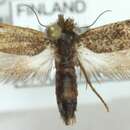Comprehensive Description
provided by Smithsonian Contributions to Zoology
Ochsenheimeria vacculella F. von Roesslerstamm
Ochsenheimeria vacculella F. von Roesslerstamm, 1842:213—Herrich-Schaeffer, 1848(5): 108, 109, 110.—Stainton, 1854: 23.—Heinemann, 1870:91.—Wocke, 1871:275.—Stainton, 1873:4, 8, 18, 20.—Snellen, 1882(1):503.—Rebel, 1901: 232—Spuler, 1910:300—Mueller-Rutz, 1914:427; 1922:234.—Meyrick, 1928:833.—Moebius, 1936:134.—Benander, 1946: 66.—Pavlov, 1961:461—Heslop, 1964:84.—Real, 1966:255—Zagulajev, 1971:41.
ADULT (Figure 6).—Small, relatively slender-bodied moths. Wing expanse: 11–12 mm; , 12–14 mm.
Head (Figures 7–9, 12–13): Vertex extremely rough, covered with long, slender scales with bidentate apices; scales stramineous to whitish at base, becoming fuscous at apex; frons very broad, smooth, covered with very broad, whitish to light brown, imbricated scales with rounded, entire apices (Figure 7). Eyes rounded, relatively small; vertical diameter of eye approximately 0.4 the interocular distance. A pair of rather large ocelli present above and lateral to antennal socket and removed from margin of eye approximately 0.5 their diameter. Antennae approximately 0.4 the length of forewing, 28–30 segmented, simple; scape elongate, slightly rough-scaled; flagellum mostly smooth, segments fuscous, banded with straminious. Maxillary palpi reduced, usually consisting of two short, ovoid segments; galea reduced, usually naked, approximately equaling labial palpi in length. Mandibles absent. Labial palpi relatively short, porrect; second segment the longest, rough beneath with a prominent apical tuft which often obscures apical (third) segment; scales stramineous with fuscous apices.
Thorax: Dorsum predominantly fuscous, slightly mottled with light brown, Venter paler, with more light-brown scales. Prothoracic tibiae without epiphysis; all legs fuscous, heavily irrorated with stramineous. Forewings fuscous, slightly mottled with light brown; venation variable, typically 10- veined; all radial veins arising separate except R4 and 5, which are stalked more than half their length; M1 usually shortly stalked to R4 + 5 but sometimes separate (Figure 21); M1 + 2 completely fused; accessory cell usually present, sometimes absent; intercalary cell and base of medial vein absent; CuA2 usually absent, vestige rarely present (Figure 22); 1A + 2A separate for half their length basally. Hindwings whitish over basal half, light fuscous over outer half; either 6- or 7-veined; Rs and M1 variable, either completely fused or separated near apex of wing; M2 and 3 arising separate from cell; base of medius weakly preserved; CuA2 absent; 1A + 2A completely fused.
Abdomen: Fuscous above; stramineous below, irrorated with fuscous; dorsum of sixth segment pale yellow.
Male genitalia (Figures 15–18): Uncus deeply lobed, lateral lobes partially enclosing elongate, darkly sclerotized anal tube; apex of anal tube not truncate, rounded. Tegumen elongate, cephalic margin deeply divided into 2 rounded lobes slightly longer than undivided caudal half. Saccus slender, tubular, nearly as long as valvae. Saccular lobe of valvae sharply triangular, with 2 or 3 stout spines. Aedeagus elongate, relatively stout and slightly curved; a pair of large vesicular pouches present, each containing numerous, elongate setae.
Female genitalia (Figure 19): Lamella postvaginalis triangular. Position of ostium slightly asymmetrical and situated to the left of median. A single signum present, consisting of an irregular and slightly sunken sclerotized area in the caudal half of the bursa.
- bibliographic citation
- Davis, Donald R. 1975. "A Review of Ochsenheimeriidae and the Introduction of the Cereal Stem Moth, Ochsenheimeria vacculella into the United States (Lepidoptera: Tineodea)." Smithsonian Contributions to Zoology. 1-20. https://doi.org/10.5479/si.00810282.192
Ochsenheimeria vacculella: Brief Summary
provided by wikipedia EN
Ochsenheimeria vacculella, the cereal stem moth, is a moth of the family Ypsolophidae. It is found in most of Europe, except Ireland, Norway, Portugal, Italy and most of the Balkan Peninsula. The species was accidentally introduced into parts of the United States.
The wingspan is 11–14 mm (0.43–0.55 in). Adults are on wing in July and August.
The larvae feed on Agropyron cristatum, Elymus caninus, Elymus repens, Bromus erectus, Bromus inermis, Festuca pratensis, Lolium, Phleum pratense, Poa, Secale cereale and Triticum aestivum. First instar larvae mine the leaves of their host plant. Later instars bore in the stems. Pupation takes place among the leaves or in crevices. The larvae have a whitish body. They can be found from April to May.
- license
- cc-by-sa-3.0
- copyright
- Wikipedia authors and editors

